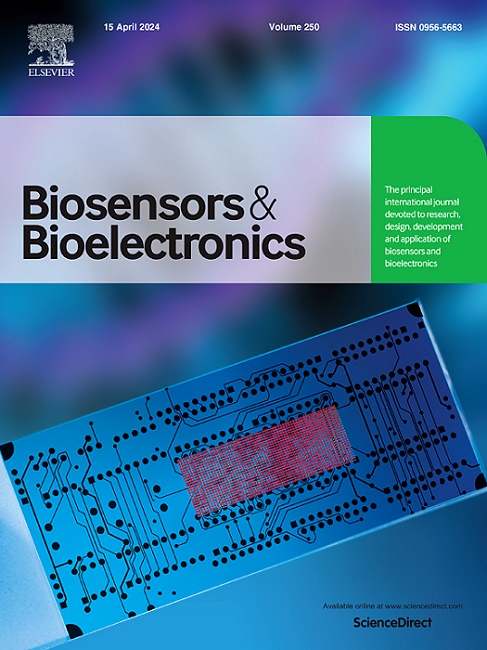An electrochemical biosensor for sensitive detection of CKAP4 with application to the diagnosis of ovarian cancer
IF 10.5
1区 生物学
Q1 BIOPHYSICS
引用次数: 0
Abstract
Cytoskeletal remodeling is crucial in tumor progression and metastasis, with cytoskeleton-associated protein 4 (CKAP4) being a key protein involved this process; however, its detection remains a challenge. In this paper, we report a solid-state electrochemistry-enhanced biosensor based on Cu-TCPP nanosheets for sensitive detection of CKAP4. In the meantime, the proposed biosensor can present high specificity in CKAP4 recognition. Specifically, upon recognition of the target, the designed catalytic hairpin assembly (CHA) reaction is successfully initiated, generating lots of DNA duplexes, which can be cleaved by Exo III to release numerous truncated thiolated signal DNA (sDNA). Subsequently, the generated sDNA is introduced to a high-conductivity electrode surface modified with Cu-TCPP nanosheets which are loaded with methylene blue. Moreover, the introduction of sDNA triggers ligand displacement via competitive coordination on this surface, thereby forming non-electroactive Cu-sDNA complexes, which significantly modulates the current signals, enabling sensitive quantification of CKAP4 levels. The biosensor may achieve a low detection limit of 0.30 pg/mL, with a broad linear range covering five orders of magnitude, and exhibits satisfying anti-interference ability in complex biological matrices. Furthermore, it displays outstanding discriminatory accuracy in differentiating ovarian cancer patient samples from healthy controls, showing great potential for cancer diagnosis.
电化学生物传感器检测CKAP4在卵巢癌诊断中的应用
细胞骨架重塑在肿瘤进展和转移中至关重要,细胞骨架相关蛋白4 (CKAP4)是参与这一过程的关键蛋白;然而,它的检测仍然是一个挑战。在本文中,我们报道了一种基于Cu-TCPP纳米片的固态电化学增强生物传感器,用于灵敏检测CKAP4。同时,该生物传感器对CKAP4的识别具有较高的特异性。具体而言,在识别目标后,设计的催化发夹组装(CHA)反应成功启动,产生大量DNA双链,Exo III可将其切割,释放出大量截断的硫代信号DNA (sDNA)。随后,将生成的sDNA引入到负载亚甲基蓝的Cu-TCPP纳米片修饰的高导电性电极表面。此外,sDNA的引入通过该表面的竞争配位触发配体位移,从而形成非电活性Cu-sDNA复合物,显著调节电流信号,使CKAP4水平的敏感量化成为可能。该传感器的检测限低至0.30 pg/mL,线性范围宽达5个数量级,在复杂的生物基质中具有良好的抗干扰能力。此外,它在区分卵巢癌患者样本和健康对照方面表现出出色的歧视性准确性,显示出癌症诊断的巨大潜力。
本文章由计算机程序翻译,如有差异,请以英文原文为准。
求助全文
约1分钟内获得全文
求助全文
来源期刊

Biosensors and Bioelectronics
工程技术-电化学
CiteScore
20.80
自引率
7.10%
发文量
1006
审稿时长
29 days
期刊介绍:
Biosensors & Bioelectronics, along with its open access companion journal Biosensors & Bioelectronics: X, is the leading international publication in the field of biosensors and bioelectronics. It covers research, design, development, and application of biosensors, which are analytical devices incorporating biological materials with physicochemical transducers. These devices, including sensors, DNA chips, electronic noses, and lab-on-a-chip, produce digital signals proportional to specific analytes. Examples include immunosensors and enzyme-based biosensors, applied in various fields such as medicine, environmental monitoring, and food industry. The journal also focuses on molecular and supramolecular structures for enhancing device performance.
 求助内容:
求助内容: 应助结果提醒方式:
应助结果提醒方式:


